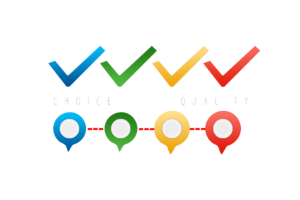Finding the right product to sell is already halfway to your success story on Amazon. Thus, you must devote as much time to researching and getting the strategies planned around your choice.
In this blog, we will walk you through the steps to finding the best products by understanding the platform, your customers, and the rest of the influencing factors for your success.
How Does Amazon Work?
I’d just like to take in a bit of space in this article to highlight Amazon’s business model. This is crucial to mention for you to understand why product research is that important to your success as an Amazon seller.
Amazon runs as a Platform-as-a-Service. To simplify, this means that both ends of the chain (sellers/supply and customers/demand) provide the value propositions for each other.
In a linear business model, it is the seller that provides the most value to the customer through its product offering. Meanwhile, in a platform business model, the customer can engage with the seller, provide feedback or review, and conduct other important interactions that can help the seller improve its products, enabling the value to be given both ways.
Amazon, in turn, acts as the enabler of the transactions by providing all the pertinent elements to make each sale successful such as the platform, payment gateway, logistics, shipping, etc. Aside from providing these, Amazon also makes sure that the supply-demand chain runs smoothly, faster, and more efficiently to save the seller time and money compared to when he does everything himself.
That said, Amazon will only provide what you need to run the business, but not the product itself. But with the right tools and research, the platform and its customers can give you plenty of ideas.
The convenience that Amazon provides attracts more sellers into its ecosystem, further increasing the competitiveness and dynamics inside.
Given all these, sellers reap a lot of advantages a platform like Amazon can provide, giving everyone almost equal footing at the beginning. With all other factors being equal, a seller is left with the rest of the variables to take care of, which includes the choice of product.
One of the best things about Amazon is that it gathers a lot of data (historically and real-time) through all the activities inside the platform since it runs a lot of the services inside the supply-demand chain. This, in turn, gives sellers insights about what products are in-demand, trending, and even most likely to be profitable soon.
Banking on the right product to sell will maximize your opportunities on Amazon. Given the competitive nature of the marketplace environment, this can also put your business in a place of competitive advantage.
Importance of Finding and Selling the Best Products on Amazon

Firstly, products that are in high demand mean you can get more sales. Consequently, you can also command a higher margin for these.
Adding a high-demand product to your store offerings can share the juice with your other product listings, present and future. Overall, it can also boost your brand’s trustworthy rating, credibility, and reputation.
A high-demand product can also improve your customer satisfaction rating. By providing a product that solves critical pain points or adds value to your customers’ lives, you can gain a lot of positive reviews and recommendations consequently.
Understanding Amazon’s Market and Customers

Who Does Amazon Sell to?
According to market analysis, Amazon targets middle-class income makers, ranging from 18 to 60 years old, both genders, singles, with families, and families with children. The average household annual income of these audiences is said to be around $85,000. What a wide scope!
You can just simply say that with its size and reach, Amazon is tailored to cater to millions of customers not just in the US but all over the world.
Imagine how powerful the platform must be to provide a seamless experience for both sellers and customers, ‘round-the-clock.
Meanwhile, Amazon Prime, the subscription-based option for Amazon users, also generates a large chunk of the profit pie for the platform. It targets loyal customers with higher purchasing power by captivating them through the free shipping all-year-round benefit.
In the US, 66% of consumers go to Amazon because of the variety of product selections on the platform. Close is 56%, which prefer to buy from it because of the free and fast shipping.
These figures can guide you to knowing the right product that will appeal to as many customers to generate the sales you aspire for. As you see, Amazon provides plenty of opportunities to different types of entrepreneurs.
What are the Products Sold on Amazon?

There is a wide selection of products you can buy and be shipped by Amazon. Here are the main categories according to its website:
- Electronics
- Computers
- Smart Home
- Arts and Crafts
- Automotive
- Baby
- Beauty and Personal Care
- Women’s Fashion
- Men’s Fashion
- Girls’ Fashion
- Boys’ Fashion
- Health and Household
- Home and Kitchen
- Industrial and Scientific
- Luggage
- Movies and Television
- Pet Supplies
- Software
- Sports and Outdoors
- Tools and Home Improvement
- Toys and Games
- Video Games
Why is Market Research Important?
The opportunities are apparent for sellers on Amazon. However, not everyone reaps the same level of success. People do not buy for the sake of buying, and priorities and trends tend to influence their choices.
With that, market research is important, both in finding the best product to sell and how you will effectively reach your target market.
Market research will help you draft the steps to start and grow your business on Amazon. Making calculated steps and informed decisions minimizes your losses and risks and at the same time, maximizes your opportunities.
Finding the Best Products

What is the Goal of the Product Research Process?
Because of the variety of products being offered by Amazon and the competitive nature among its sellers, the goal of product research is to help you acquire the products at the lowest price and sell that with the highest profit margin possible.
Simply put, you have to look for products that are in demand, fast-moving, and can be sold in bulk.
How to Do Product Research?
Be imaginative and sensitive around an unfulfilled need
As they say, necessity is the mother of invention. Start by looking for market gaps and consumer needs that you can fulfill or improve. You can also take an existing product and innovate it by adding features or making it work faster or more efficiently.
Do keyword research
Keywords signify what kinds of products that a vast number of consumers look for and buy on Amazon. Using keyword tools, you can derive the list of trending keywords in your niche of choice.
Check the Amazon’s Best Seller List
You can also start by looking on Amazon’s Best Seller list. This is updated from time to time so make sure to spot the trends and analyze the movement before delving into your product choice.
Do the math
Now that you have shortlisted your product options, look for potential suppliers and compute for the highest possible profit margin you can add. Analyze your numbers and see if you can be profitable on the platform. Don’t forget to factor in platform costs like shipping and handling, storage fees, advertising costs, etc.
What are the Other Factors to Consider?
You also have to go deeper into understanding how your product will fare against the trends, which we all know are ever-changing and continuously evolving. This is important especially when you want to grow and scale your business on Amazon, and not just reap a one-time big success.
Product Demand
If you are looking for staying power, you have to check for product demand. And it is not just understanding if you have customers for your product, but also finding ways how to keep creating a demand for it. It could be complementing other products, continuous innovation, and investing in advertising for sustained visibility.
Competition
A highly competitive product signals a high demand. And being a new entrant to the roster of sellers already selling a product, you have to know if you can compete, head-on. Assess your capacity to innovate and invest in advertising. Look for the best suppliers that will give you the lowest prices.
Profitability
And lastly, look for a product that will give you profits, not just a break-even. Remember that Amazon will ask you to pay to use the platform. Though for small business owners, selling on the platform is actually less costly and more cost-efficient in the long run because the platform takes care of almost everything on their behalf. This is also because you do not need to capitalize as much on resources as any startup would normally do.
And lastly, complement your products with the right sales and marketing strategy. Boost your chances of success and hasten your growth by using AI and automation tools.
Conclusion
Maximizing your earnings on Amazon means minimizing your costs. Make sure you are updated on the trends and algorithm updates and optimize your product listing accordingly. Be open to improvements, do continuous optimization, and apply innovation. Keep on learning from the experts and from your own experience – both wins and mistakes, and continue to grow as an Amazon seller.

